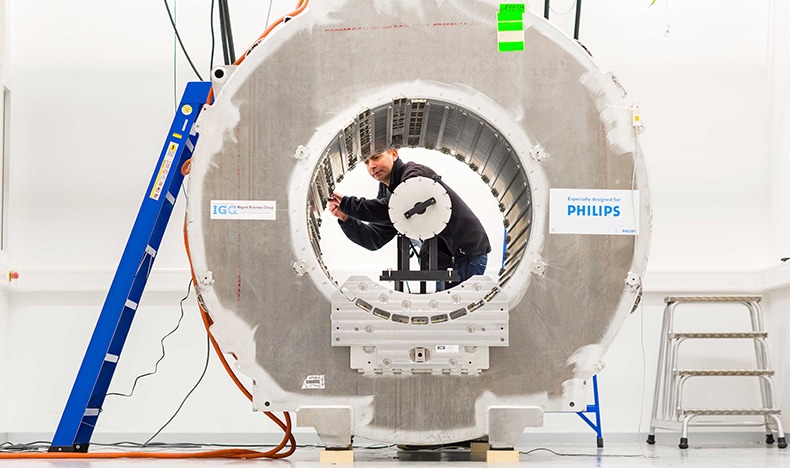5 lessons from our journey toward net-zero healthcare delivery
Nov 04, 2025 | 4 minute read
Achieving net-zero healthcare will require action across the entire value chain. Through responsible innovation, collaboration, EcoDesign and circularity, we can help cut emissions, strengthen resilience and deliver care that supports both people and the planet.

Many hospitals and health systems around the world are already feeling the effects of a changing climate. From rising respiratory illnesses and heat-related mortality [1] to disruptions in global supply chains, climate change has become a public health emergency, disproportionally impacting underserved and marginalized populations [2].
Every decision in healthcare can shape lives, and today, it also shapes the health of our planet.
The health of people and the health of the planet are inseparable. With the healthcare sector responsible for more than 4% of global carbon emissions [3], the industry has both a responsibility and an opportunity to lead the way toward a more sustainable future.
That’s why we embed sustainability into the heart of how we innovate, operate and collaborate – not as an add-on, but as a core enabler of delivering better care for more people.
We’ve been driving the sustainable and equitable transition of healthcare for many years. Since 2020, Philips has been carbon neutral in its operations (Scopes 1 and 2), enabled through joint renewable electricity partnerships that help secure a clean energy supply across our sites.
Recently, our science-based net-zero target was validated by the Science Based Targets initiative (SBTi). We aim to achieve net-zero greenhouse gas emissions across our value chain by 2045 – five years ahead of the Intergovernmental Panel on Climate Change’s (IPCC) recommendation for a 1.5 °C global warming pathway.
This goal guides everything we do – from designing innovative, energy-efficient and increasingly compact medical solutions, to scaling the adoption of circular practices that reduce material use and waste both in hospitals and across the healthcare value chain.

Everyone in the healthcare ecosystem can help advance net-zero goals. Here are five lessons from our journey toward net zero so far, what they mean for the future of healthcare, and how they’re helping us set the standard in healthcare delivery worldwide together with an ecosystem of partners.
Lesson 1: Addressing scope 3 emission reduction is where the real work begins
For many healthcare organizations, scope 3 emissions (those beyond direct control) represent the largest share of their environmental footprint. Reducing them is complex, but it’s also where the greatest impact lies. In the case of hospitals, scope 3 greenhouse gas emissions might come from the medicine, food, equipment and waste treatment services.
Yet the real challenge – and opportunity – lies in scope 3, especially during the use phase of our products. More than 60% of our total value chain emissions stem from the electricity consumed when our systems are in use by customers. That’s why we focus on designing energy-efficient solutions by default.
Our EcoDesign program ensures that every new product introduction meets certain environmental criteria. By the end of this year (2025), our goal is that all new product introductions (NPI) adhere to the Philips EcoDesign process and requirements. Meeting growing customer demand to support their environmental ambitions, these products are designed to increase energy efficiency and circularity across the product life cycle, with sustainable material choices supporting reduced- and sustainable material use in packaging, for example by considering the use of recycled or biobased material alternatives.
For example, the latest generation of our Magnetic Resonance (MR) systems includes SmartSpeed technology, boosting imaging speed by up to 3 times and reducing power consumption by up to 59% per scan [4]. In patient monitoring, innovations such as EcoModes and PowerSave+ features reduce idle energy use without compromising clinical performance. Beyond EcoDesign, our remote service offerings can extend the customer use-time of products and our circular service models, including take back and refurbishment or recycling at end of use, can help lower environmental impact and total cost of ownership for hospitals. At the same time, through innovative design and digitalization, we are enabling care to reach more patients, treat them faster and in a more tailored fashion.

Healthcare professionals today face mounting pressures, from growing demand and workforce shortages to budget constraints and regulatory complexity. For most, the largest emissions aren’t those within their direct control, but understanding where emissions occur – and making energy efficiency a procurement priority – can turn sustainability into an immediate, measurable outcome, that contributes to higher sustainability standards and more responsible sourcing practices.
By focusing on the use phase and scope 3 greenhouse gas emissions, healthcare organizations can help deliver care that’s sustainable in every sense – clinically, financially and environmentally.
Lesson 2: Driving sustainable healthcare through collaboration
No organization can decarbonize healthcare alone. Partnerships across value chains can help translate ambition into results.
The Champalimaud Foundation in Portugal shows us what’s possible. One year into a five-year partnership with Philips, the Champalimaud Foundation reduced the emissions in its radiology and nuclear medicine department by 24% per exam, through EcoDesign equipment replacement, refurbishment and incorporating circular practices. The partnership’s five-year goal is to halve emissions by 20 28, with third-party validation, with additional actions including workflow optimization and renewable energy.

Similar collaborations are underway with Rennes University Hospital in France and Vanderbilt University Medical Center in the US, which recently published research on both the financial and environmental benefits of circular business models and the environmental impact of magnetic resonance (MR) and computed tomography (CT) imaging using life cycle assessment (LCA), focusing on energy and material use.
In every case, and underpinned by specific local needs, we are co-creating strategic roadmaps to decarbonize care delivery while lowering operational costs.
Lesson 3: Sustainable procurement as a catalyst for net-zero healthcare
Procurement is one of the most powerful levers for accelerating the transition to net-zero healthcare, and healthcare providers can help to drive systemic change across the industry.
Sustainable procurement means embedding climate change mitigation criteria into purchasing decisions – prioritizing energy-efficient, circular and digitally-enabled solutions.
When healthcare buyers ask the right questions and apply consistent sustainability standards, they can drive measurable impact far beyond their own operations. Each purchasing decision influences not only cost and clinical performance but also the environmental footprint of the entire value chain.
The globally agreed sustainable purchasing criteria for imaging equipment are a good example. Drawing on existing standards and procurement best practices, these collectively help drive and scale sustainable practices in radiology, including criteria for greenhouse gas reporting and reduction, circular design, transparency on product performance, digital solutions that support decarbonization and dematerialization, and public disclosure of social impact.
When healthcare organizations use their purchasing power to reward responsible innovation, they strengthen supply chains, stimulate market transformation, and help deliver care that supports both people and the planet. As healthcare organizations set sustainability standards through procurement, manufacturers and suppliers must work together to meet them.
Lesson 4: Turning ideas into collective action and impact at scale
Aligning suppliers, manufacturers and healthcare providers around shared accountability and measurable progress calls for deep collaboration.
Our supplier sustainability program – featured in Fortune’s 2024 ‘Change the World’ rankings – is designed to make it easier for suppliers to meet ESG standards and reduce emissions. This is helping to overcome system-wide challenges in the supply chain. A dedicated AI tool, developed with Eindhoven University of Technology, helps to determine the most important factors that suppliers should address to ensure they meet established sustainability targets. The outcome is a plan for how individual suppliers can and should improve.
This has led to safer workplaces, lower costs and more resilient supply chains.

By the end of 2025, we expect at least half of our suppliers (by spend) to commit to science-based CO₂ reduction targets. Our maturity-based collaboration model fosters transparency, learning and trust – an approach that can be replicated across industries.
Progress at scale depends on this kind of shared commitment. When suppliers, manufacturers, and healthcare providers align on the same standards and goals, sustainability can become a practical part of everyday operations.
Lesson 5: Expanding partnerships beyond healthcare for net-zero goals
To achieve net-zero emissions in healthcare, we must look beyond our own walls and even beyond our sector.
Through the World Economic Forum’s Alliance of CEO Climate Leaders – representing 130-plus companies and USD 4 trillion in combined revenue – Philips contributes to global efforts to scale Scope 3 reduction. Between 2019 and 2023, members reduced aggregate greenhouse gas emissions by 12% while growing revenue by 20%. In an open letter, leaders wrote that ‘the climate economy is delivering’.
Another example is our contribution to the new Global Circularity Protocol (GCP), launching at COP30, as the world’s first global framework for standardized and comparable circularity reporting and managing circularity – a much-needed step towards a sustainable and healthy future. At Philips, circularity is a powerful lever to reduce material use and our overall impact on climate and nature. Embedding circular practices and innovations can help hospitals with reducing their environmental footprint, while improving healthcare resilience and patient outcomes.
A shared call to action for net-zero healthcare
As the world looks to COP30 in Brazil, we see a pivotal moment to accelerate collective action that could benefit both human health and the health of our planet.
As healthcare leaders, clinicians, suppliers and policymakers, we all have a role to play.
Let’s team up to collectively reduce scope 3 greenhouse gas emissions in healthcare. Ask your suppliers about their climate commitments. Choose equipment designed for circularity. Share your challenges openly so we can co-create innovative solutions for clinical settings.
This is meaningful innovation in action, designed for better outcomes and a better future for all.
Sources [1] https://www.who.int/news-room/fact-sheets/detail/climate-change-and-health [2] https://www.epa.gov/newsreleases/epa-report-shows-disproportionate-impacts-climate-change-socially-vulnerable [3] Health Care Without Harm (2019). Health care’s climate footprint: How the health sector contributes to the global climate crisis and opportunities for action (p.22). https://noharm-global.org/documents/health-care-climate-footprint-report [4] Applicable to BlueSeal XE. Philips SmartSpeed power consumption versus Philips SENSE based scanning. Based on COCIR and in-house simulated environment








